Estimating Nitrogen Load Resulting from Biofuel Mandates
Abstract
:1. Introduction
2. Materials and Methods
2.1. Estimating Total Nitrogen Runoff
2.2. Load Estimation
2.3. Hydrologic Network
2.4. Input Sources, Transport and Decay Variables.
2.5. Scenarios
2.6. Nitrogen Management Strategy
3. Results
3.1. Calibration Results
3.2. Model Predictions
4. Discussions
5. Conclusions
Acknowledgments
Author Contributions
Conflicts of Interest
References
- H.R.6—Energy Independence and Security Act of 2007. Available online: https://www.congress.gov/bill/110th-congress/house-bill/6 (accessed on 15 August 2010).
- EPA. Hypoxia in the Northern Gulf of Mexico: An Update by the EPA Science Advisory Board. 2007. Available online: https://yosemite.epa.gov/sab/sabproduct.nsf/C3D2F27094E03F90852573B800601D93/$File/EPA-SAB-08–003complete.unsigned.pdf (accessed on 4 August 2014). [Google Scholar]
- EPA. Nitrous Oxide: Sources and Emissions. Available online: https://www3.epa.gov/climatechange/ghgemissions/gases/n2o.html (accessed on 12 May 2013).
- EPA. Moving Forward on Gulf Hypoxia Annual Report 2011. Available online: https://www.epa.gov/sites/production/files/2015-04/documents/hypoxia_task_force_annual_report_2011.pdf (accessed on 14 Febeuary 2012).
- Gowda, P.H.; Dalzell, B.J.; Mulla, D.J. Model Based Nitrate TMDLs for Two Agricultural Watersheds of Southeastern Minnesota. JAWRA J. Am. Water Res. Assoc. 2007, 43, 254–263. [Google Scholar] [CrossRef]
- Kladivko, E.J.; Frankenberger, J.R.; Jaynes, D.B.; Meek, D.W.; Jenkinson, B.J.; Fausey, N.R. Nitrate Leaching to Subsurface Drains as Affected by Drain Spacing and Changes in Crop Production System. J. Environ. Qual. 2004, 33, 1803–1813. [Google Scholar] [CrossRef] [PubMed]
- Simpson, T.; Sharpley, A.; Howarth, R. The New Gold Rush: Fueling Ethanol Production while Protecting Water Quality. J. Environ. Qual. 2008, 37, 318–324. [Google Scholar] [CrossRef] [PubMed]
- Thomas, M.A. Water Quality Impacts of Corn Production to Meet Biofuel Demands. J. Environ. Eng. 2009, 135, 1123. [Google Scholar] [CrossRef]
- U.S. Energy Information Administration. Annual Engergy Outlook 2012 with Projections to 2035. Available online: http://www.eia.gov/forecasts/aeo/pdf/0383%282012%29.pdf (accessed on 12 October 2013).
- USDA. Economic Research Services. Available online: http://www.ers.usda.gov/ (accessed on 22 June 2014).
- Dias De Oliveira, M.E.; Vaughan, B.E.; Rykiel, E.J. Ethanol as Fuel: Energy, Carbon Dioxide Balances, and Ecological Footprint. Bioscience 2005, 55, 593–602. [Google Scholar] [CrossRef]
- Pimentel, D.; Patzek, T.W. Ethanol Production using Corn, Switchgrass, and Wood; Biodiesel Production using Soybean and Sunflower. Nat. Res. Res. 2005, 14, 65–76. [Google Scholar] [CrossRef]
- Robertson, G.P.; Hamilton, S.K.; Del Grosso, S.J. The Biogeochemistry of Bioenergy Landscapes: Carbon, Nitrogen, and Water Considerations. Ecol. Appl. 2011, 21, 1055–1067. [Google Scholar] [CrossRef] [PubMed]
- Costello, C.; Griffin, W.M.; Landis, A.E. Impact of Biofuel Crop Production on the Formation of Hypoxia in the Gulf of Mexico. Environ. Sci. Technol. 2009, 43, 7985–7991. [Google Scholar] [CrossRef] [PubMed]
- McLaughlin, S.B.; Kszos, L.A. Development of Switchgrass (Panicum Virgatum) as a Bioenergy Feedstock in the United States. Biomass Bioenergy 2005, 28, 515–535. [Google Scholar] [CrossRef]
- Parrish, D.J.; Fike, J.H. The Biology and Agronomy of Switchgrass for Biofuels. Crit. Rev. Plant Sci. 2005, 24, 423–459. [Google Scholar] [CrossRef]
- Secchi, S.; Gassman, P.; Jha, M. Potential Water Quality Changes due to Corn Expansion in the Upper Mississippi River Basin. Ecol. Appl. 2011, 21, 1068–1084. [Google Scholar] [CrossRef] [PubMed]
- Lowrance, R.; Altier, L.S.; Newbold, J.D. Water Quality Functions of Riparian Forest Buffers in Chesapeake Bay Watersheds. Environ. Manag. 1997, 21, 687–712. [Google Scholar] [CrossRef]
- Korom, S.F. Natural Denitrification in the Saturated Zone: A Review. Water Resour. Res. 1992, 28, 1657–1668. [Google Scholar] [CrossRef]
- Vidon, P.G.; Hill, A.R. Landscape Controls on Nitrate Removal in Stream Riparian Zones. Water Resour. Res. 2004, 40. [Google Scholar] [CrossRef]
- Doering, O.C.; Diaz-Hermelo, F.; Howard, C. Evaluation of the Economic Costs and Benefits of Methods for Reducing Nutrient Loads to the Gulf of Mexico. Available online: http://aquaticcommons.org/14638/ (accessed on 24 April 2011).
- Dosskey, M.G. Toward Quantifying Water Pollution Abatement in Response to Installing Buffers on Crop Land. Environ. Manag. 2001, 28, 577–598. [Google Scholar] [CrossRef] [PubMed]
- Lee, K.H.; Isenhart, T.M.; Schultz, R.C. Sediment and Nutrient Removal in an Established Multi-Species Riparian Buffer. J. Soil Water Conserv. 2003, 58, 1. [Google Scholar]
- Mayer, P.M.; Reynolds, S.K.; McCutchen, M.D. Meta-Analysis of Nitrogen Removal in Riparian Buffers. J. Environ. Qual. 2007, 36, 1172–1180. [Google Scholar] [CrossRef] [PubMed]
- Ribaudo, M.O.; Heimlich, R.; Peters, M. Nitrogen Sources and Gulf Hypoxia: Potential for Environmental Credit Trading. Ecol. Econ. 2005, 52, 159–168. [Google Scholar] [CrossRef]
- Secchi, S.; Babcock, B. Impact of High Crop Prices on Environmental Quality: A Case of Iowa and the Conservation Reserve Program. Available online: http://lib.dr.iastate.edu/card_workingpapers/471/ (accessed on 3 July 2015).
- Tufekcioglu, A.; Raich, J.; Isenhart, T. Biomass, Carbon and Nitrogen Dynamics of Multi-Species Riparian Buffers within an Agricultural Watershed in Iowa, USA. Agroforestry Syst. 2003, 57, 187–198. [Google Scholar] [CrossRef]
- Smith, R.A.; Schwarz, G.E.; Alexander, R.B. Regional Interpretation of Water-Quality Monitoring Data. Water Resour. Res. 1997, 33, 2781–2798. [Google Scholar] [CrossRef]
- Schwarz, G.E.; Hoos, A.B.; Alexander, R.B.; Smith, R.A. The SPARROW Surface Water-Quality Model: Theory, Application and User Documentation; USGS: Denver, CO, USA, 2009.
- Alexander, R.B.; Smith, R.A.; Schwarz, G.E. Differences in Phosphorus and Nitrogen Delivery to the Gulf of Mexico from the Mississippi River Basin. Environ. Sci. Technol. 2007, 42, 822–830. [Google Scholar] [CrossRef]
- Moore, R.B.; Johnson, C.M.; Robinson, K.W. Estimation of Total Nitrogen and Phosphorus in New England Streams Using Spatially Referenced Regression Models; USGS: Denver, CO, USA, 2004.
- Wallander, S. While Crop Rotations are Common, Cover Crops Remain Rare. Available online: https://www.questia.com/magazine/1P3-3093730721/while-crop-rotations-are-common-cover-crops-remain (accessed on 4 Septermer 2013).
- Saad, D.A.; Schwarz, G.E.; Robertson, D.M. A Multi-Agency Nutrient Dataset used to Estimate Loads, Improve Monitoring Design, and Calibrate Regional Nutrient SPARROW Models1. JAWRA J. Am. Water Resour. Assoc. 2011, 47, 933–949. [Google Scholar] [CrossRef] [PubMed]
- Cohn, T.A.; Caulder, D.L.; Gilroy, E.J. The Validity of a Simple Statistical Model for Estimating Fluvial Constituent Loads: An Empirical Study Involving Nutrient Loads Entering Chesapeake Bay. Water Resour. Res. 1992, 28, 2353–2363. [Google Scholar] [CrossRef]
- Nolan, J.V.; Brakebill, J.W.; Alexander, R.B. ERF1_2-Enhanced River Reach File 2.0; Geological Survey: Denver, CO, USA, 2002.
- Maupin, M.A.; Ivahnenko, T. Nutrient Loadings to Streams of the Continental United States from Municipal and Industrial Effluent1. JAWRA J. Am. Water Resour. Assoc. 2011, 47, 950–964. [Google Scholar] [CrossRef] [PubMed]
- EPA. Envirofacts Data Warehouse, Permit Compliance System; EPA: Washington, DC, USA, 2013.
- Wieczorek, M.E.; LaMotte, A.E. Attributes for MRB_E2RF1 Catchments by Major River Basins in the Conterminous United States: Normalized Atmospheric Deposition for 2002, Total Inorganic Nitrogen. Available online: https://pubs.er.usgs.gov/publication/70046765 (accessed on 30 November 2015).
- Elliott, E.M.; Kendall, C.; Wankel, S.D. Nitrogen Isotopes as Indicators of NOx Sources Contributions to Atmospheric Nitrate Deposition Across the Midwestern and Northeastern United States. Environ. Sci. Technol. 2010, 41, 7661–7667. [Google Scholar] [CrossRef]
- Wieczorek, M.E.; LaMotte, A.E. Attributes for MRB_E2RF1 Catchments by Major River Basins in the Conterminous United States: NLCD 2001 Land use and Land Cover. Available online: https://www.sciencebase.gov/catalog/item/51d2a4e4e4b0ca18483389ff (accessed on 30 November 2015).
- Homer, C.; Dewitz, J.; Fry, J. Completion of the 2001 National Land Cover Database for the Conterminous United States. Photogramm. Eng. Remote Sensing 2007, 73, 337. [Google Scholar]
- Wieczorek, M.E.; LaMotte, A.E. Attributes for MRB_E2RF1 Catchments by Major River Basins in the Conterminous United States: Nutrient Application (Phosphorus and Nitrogen) for Fertilizer and Manure Applied to Crops (Cropsplit), 2002. Available online: https://pubs.er.usgs.gov/publication/dds49117 (accessed on 30 November 2015).
- Ruddy, B.C.; Lorenz, D.L.; Mueller, D.K. County-Level Estimates of Nutrient Inputs to the Land Surface of the Conterminous United States, 1982–2001. U.S. Geological Survey Scientific Investigations Report 2006–5012; U.S. Geological Survey: Reston, VA, USA, 2006.
- Wieczorek, M.E.; LaMotte, A.E. Attributes for MRB_E2RF1 Catchments by Major River Basins in the Conterminous United States: Average Daily Maximum Temperature, 2002. Available online: https://pubs.er.usgs.gov/publication/dds49128 (accessed on 30 November 2015).
- Wieczorek, M.E.; LaMotte, A.E. Attributes for MRB_E2RF1 Catchments by Major River Basins in the Conterminous United States: 30-Year Average Daily Minimum Temperature, 1971–2000. Available online: https://pubs.er.usgs.gov/publication/DDS (accessed on 30 November 2015).
- PRISM Climate Group. Available online: http://oldprism.nacse.org/ (accessed on 30 November 2015).
- Wieczorek, M.E.; LaMotte, A.E. Attributes for MRB_E2RF1 Catchments by Major Rivers Basins in the Conterminous United States: Total Precipitation, 2002. Available online: https://pubs.er.usgs.gov/publication/dds49120 (accessed on 30 November 2015).
- Wolock, D.M. STATSGO Soil Characteristics for the Conterminous United States. Available online: http://water.usgs.gov/GIS/metadata/usgswrd/XML/muid.xml (accessed on 30 November 2015).
- Wieczorek, M.E.; LaMotte, A.E. Attributes for MRB_E2RF1 Catchments by Major River Basins in the Conterminous United States: Basin Characteristics, 2002. Available online: https://pubs.er.usgs.gov/publication/dds49103 (accessed on 30 November 2015).
- Robertson, D.; Saad, D. Nutrient Inputs to the Laurentian Great Lakes by Source and Watershed Estimated using SPARROW Watershed Models1. JAWRA J. Am. Water Resour. Assoc. 2011, 47, 1011–1033. [Google Scholar] [CrossRef] [PubMed]
- Miller, S.A.; Landis, A.E.; Theis, T.L. Use of Monte Carlo Analysis to Characterize Nitrogen Fluxes in Agroecosystems. Environ. Sci. Technol. 2006, 40, 2324–2332. [Google Scholar] [CrossRef] [PubMed]
- Bai, Y.; Luo, L.; van der Voet, E. Life Cycle Assessment of Switchgrass-Derived Ethanol as Transport Fuel. Int. J. Life Cycle Assess. 2010, 15, 468–477. [Google Scholar] [CrossRef]
- Nelson, R.G.; Ascough, J.C.; Langemeier, M.R. Environmental and Economic Analysis of Switchgrass Production for Water Quality Improvement in Northeast Kansas. J. Environ. Manag. 2006, 49, 336–347. [Google Scholar] [CrossRef] [PubMed]
- Schmer, M.R.; Vogel, K.P.; Mitchell, R.B. Net Energy of Cellulosic Ethanol from Switchgrass. Proc. Natl. Acad. Sci. USA 2008, 105, 464–469. [Google Scholar] [CrossRef] [PubMed]
- Hill, J.; Nelson, E.; Tilman, D. Environmental, Economic, and Energetic Costs, and Benefits of Biodiesel and Ethanol Biofuels. Proc. Natl. Acad. Sci. USA 2006, 103, 11206–11210. [Google Scholar] [CrossRef] [PubMed]
- King, C.W.; Webber, M.E. Water Intensity of Transportation. Environ. Sci. Technol. 2008, 42, 7866–7872. [Google Scholar] [CrossRef] [PubMed]
- USDA. National Agricultural Statics Service. 2013. Available online: http://www.nass.usda.gov/ (accessed on 30 November 2015). [Google Scholar]
- Duffy, M. Estimated Costs for Production, Storage, and Transportation of Switchgrass. Available online: http://econpapers.repec.org/paper/isugenres/12917.htm (accessed on 30 November 2015).
- Gerbens-Leenes, W.; Hoekstra, A.Y. The Water Footprint of Biofuel-Based Transport. Energy Environ. Sci. 2011, 4, 2658–2668. [Google Scholar] [CrossRef]
- USDA. National Agricultural Statistics Service. 2015. Available online: http://www.usda.gov/wps/portal/usda/usdahome?contentidonly=true&contentid=NASS_Agency_Splash.xml (accessed on 30 November 2015). [Google Scholar]
- Bentrup, G. Conservation Buffers: Design Guidelines for Buffers, Corridors, and Greenways. Available online: http://www.treesearch.fs.fed.us/pubs/33522 (accessed on 30 November 2015).
- USGS. The National Hydrography Dataset (NHD). 2014. Available online: http://nhd.usgs.gov/ (accessed on 30 November 2015). [Google Scholar]
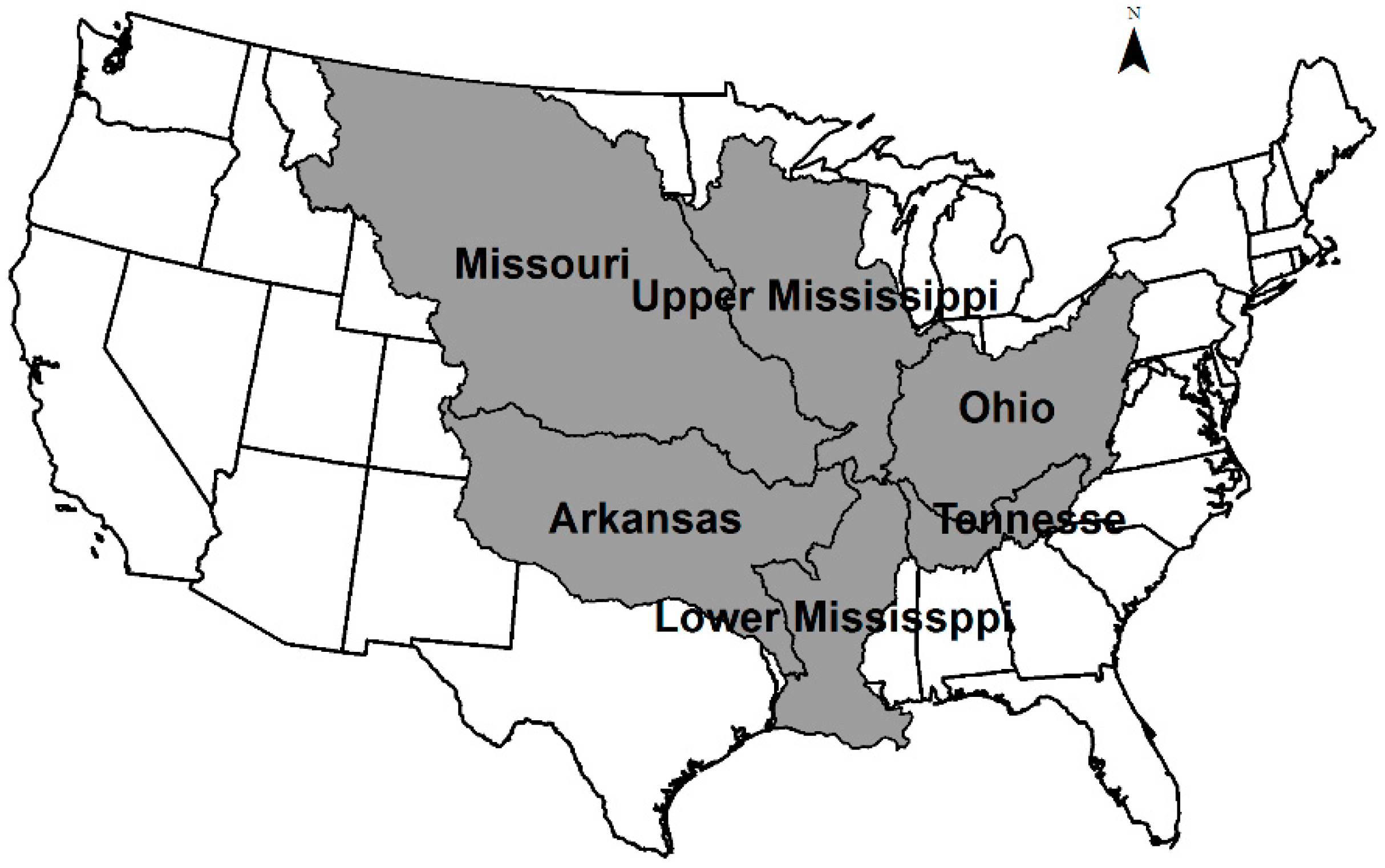
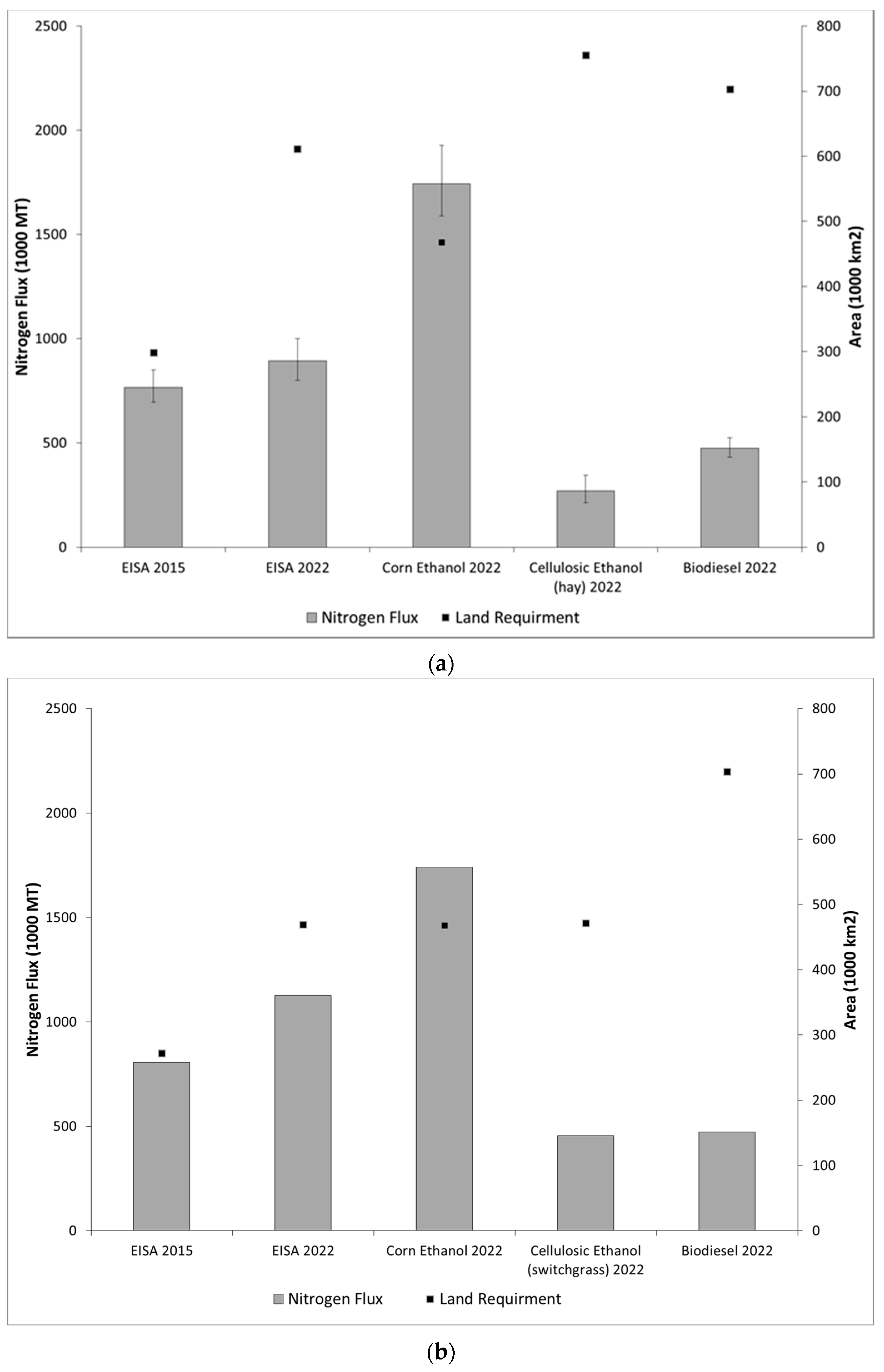
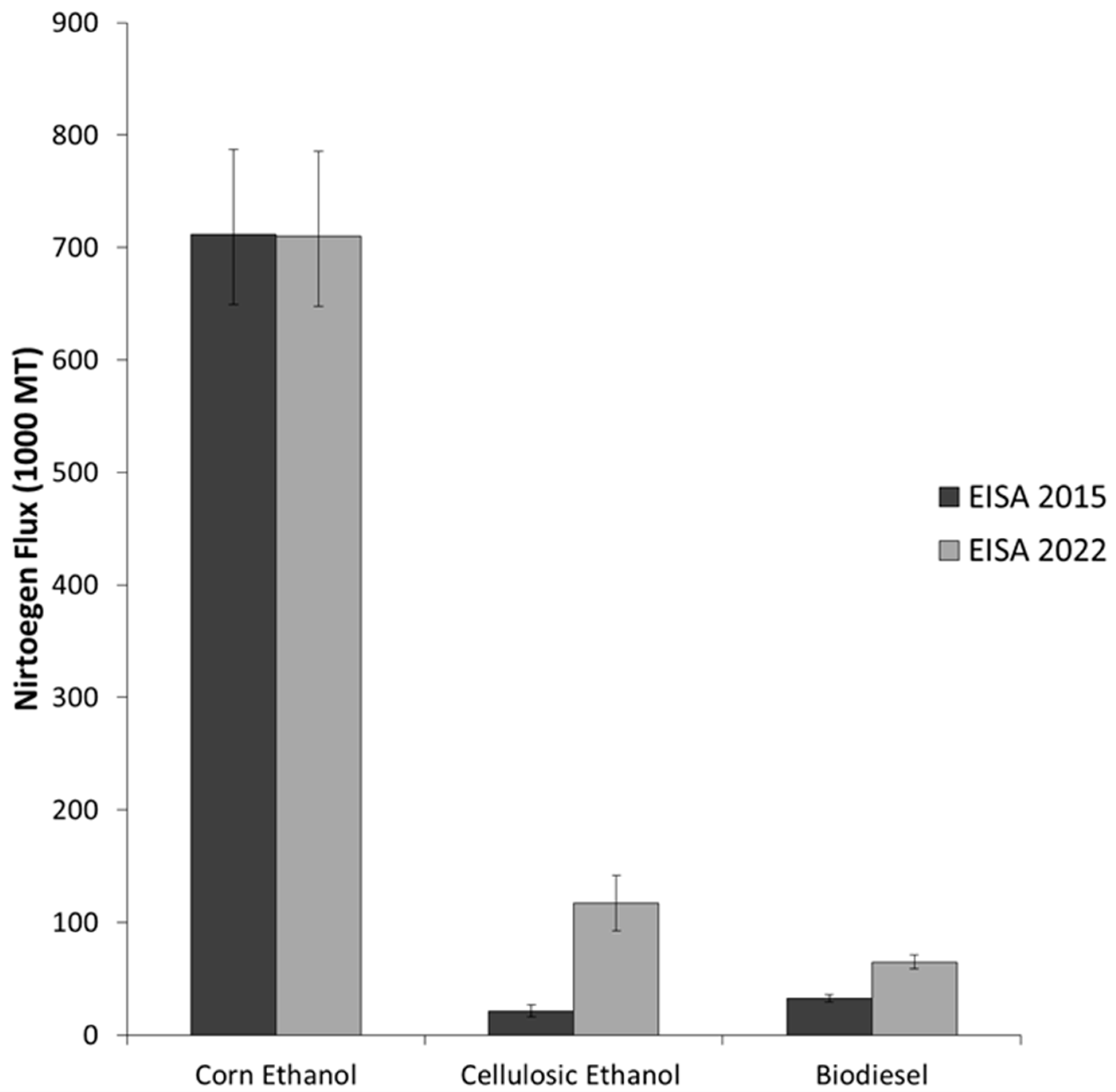
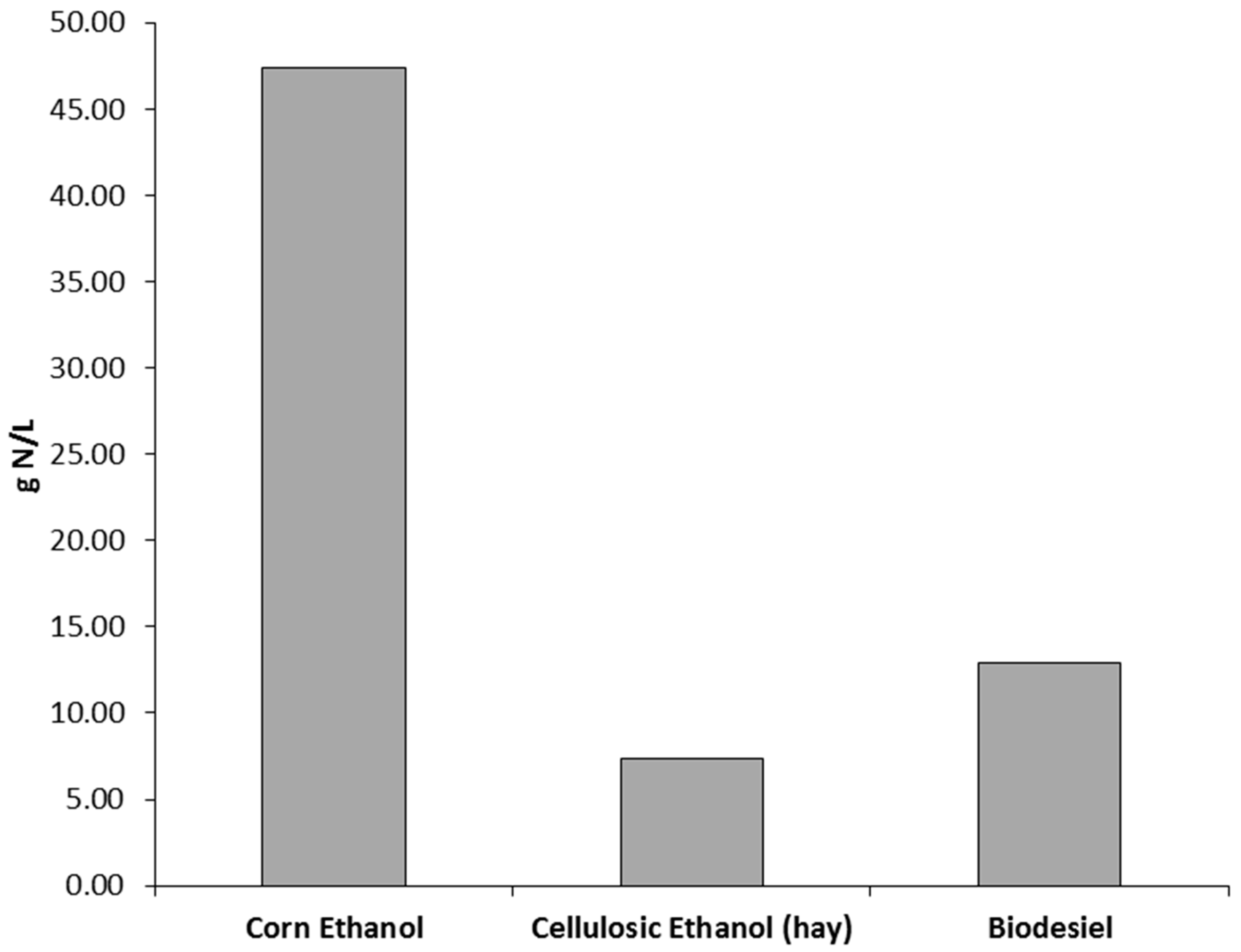
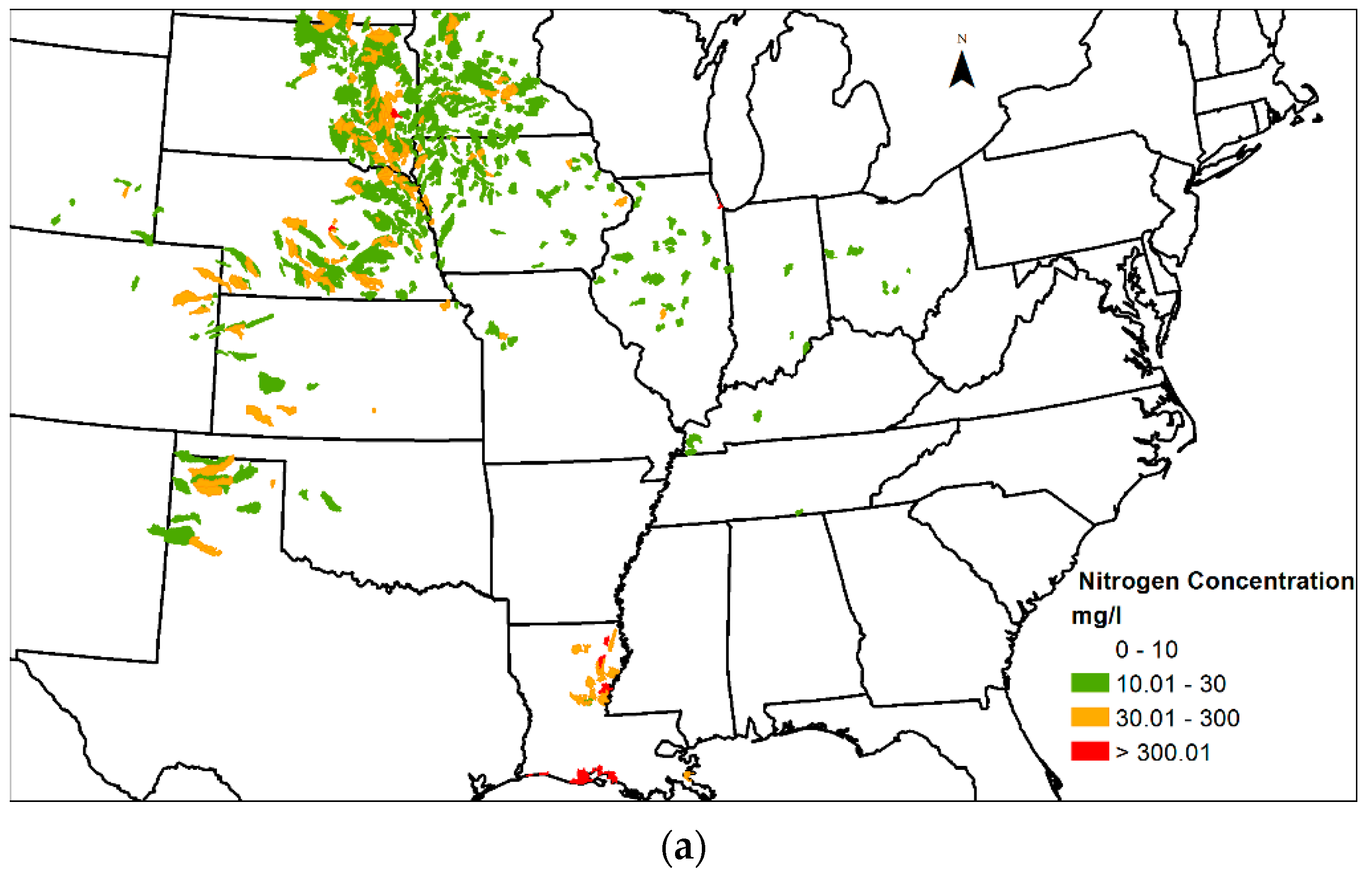
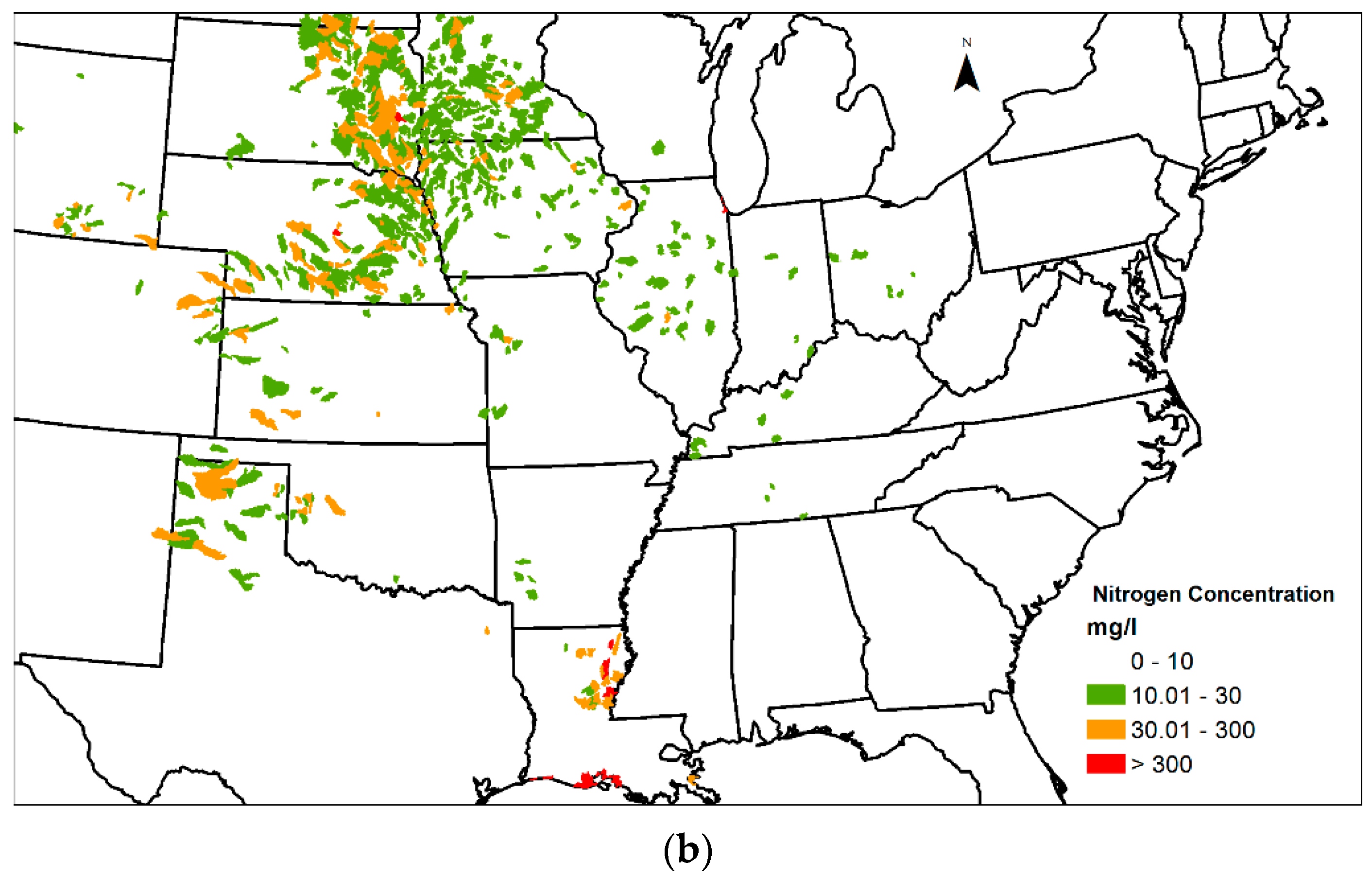
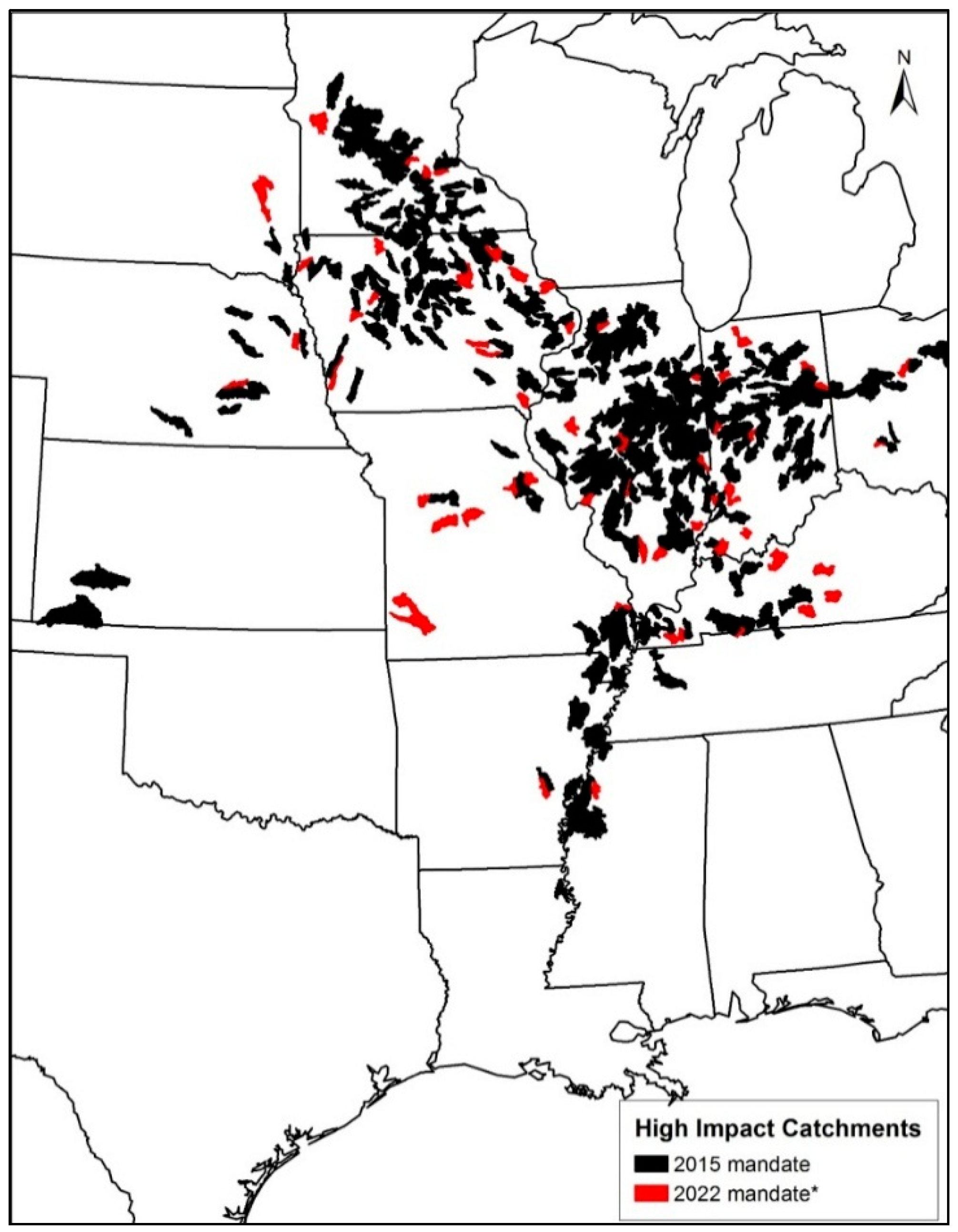
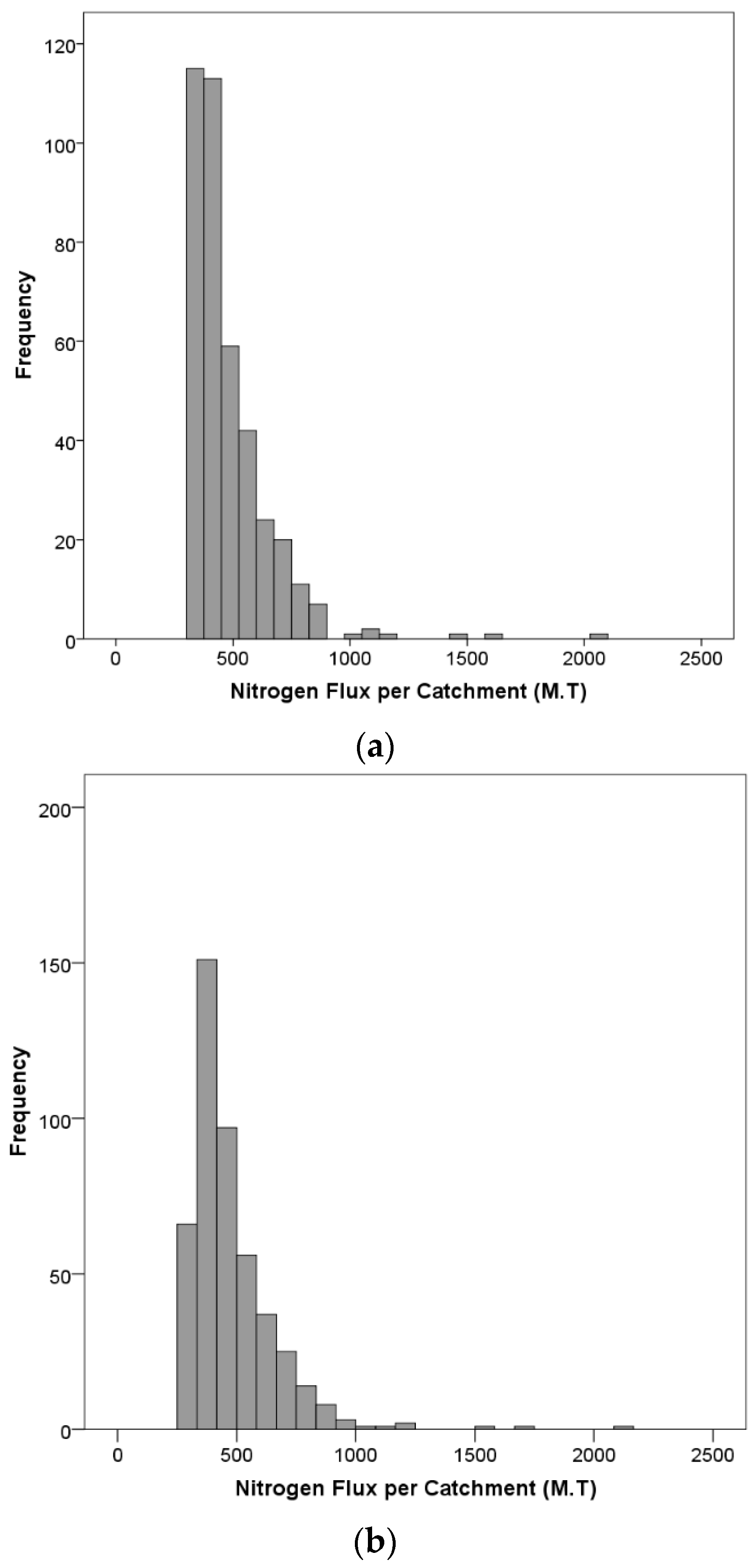
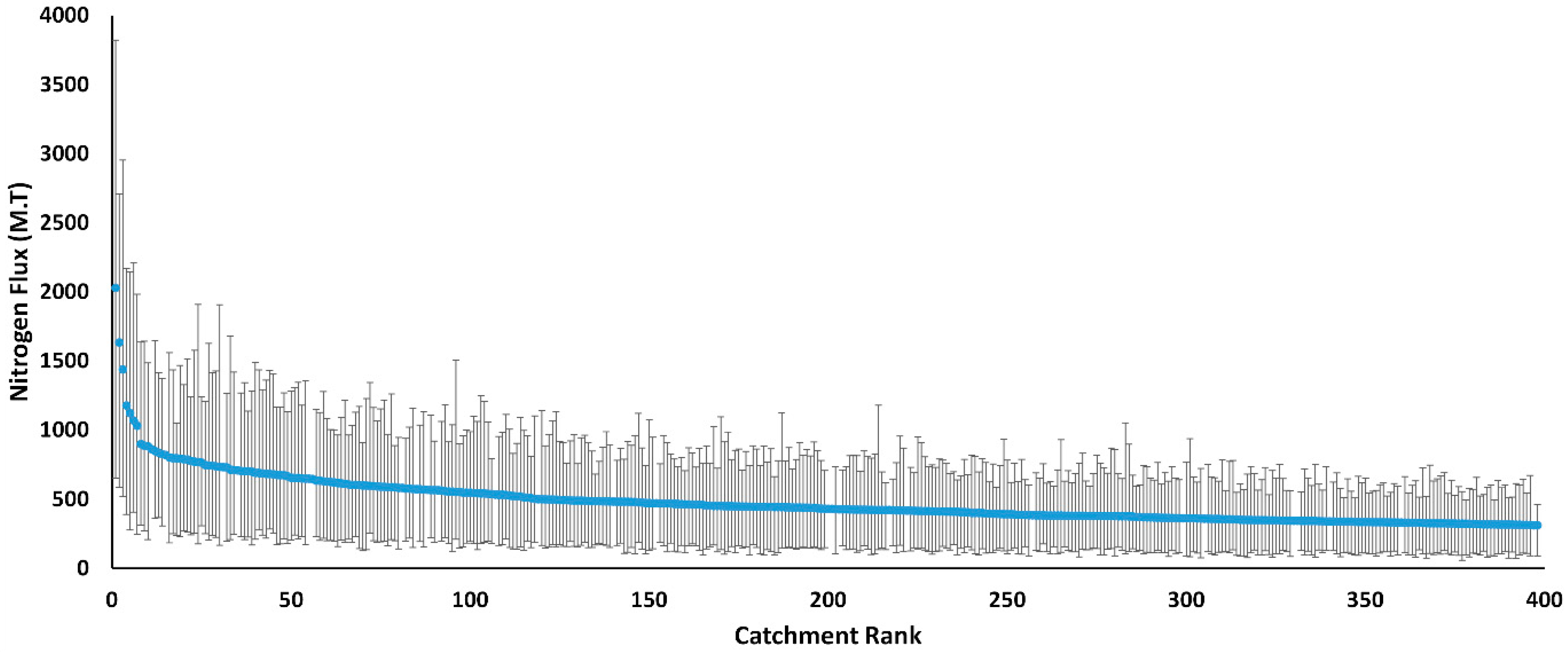
| Year | Corn Ethanol | Cellulosic Ethanol | Other Sources, i.e., Biodiesel | Total |
|---|---|---|---|---|
| 2011 | 48 | 1 | 4 | 53 |
| 2012 | 50 | 2 | 6 | 58 |
| 2013 | 52 | 4 | 7 | 63 |
| 2014 | 55 | 7 | 8 | 69 |
| 2015 | 57 | 11 | 9 | 78 |
| 2016 | 57 | 16 | 11 | 84 |
| 2017 | 57 | 21 | 13 | 91 |
| 2018 | 57 | 26 | 15 | 98 |
| 2019 | 57 | 32 | 17 | 106 |
| 2020 | 57 | 40 | 17 | 114 |
| 2021 | 57 | 51 | 17 | 125 |
| 2022 | 57 | 61 | 19 | 136 |
| Parameter | Units | Coefficient Units | NWLS Estimate | Confidence Interval | Standard Error | p-Value | Bootstrap Estimate | |
|---|---|---|---|---|---|---|---|---|
| Lower 90% | Upper 90% | |||||||
| Sources | ||||||||
| Nitrogen applied to corn/soy | kg·N/year | Fraction | 0.195 | 0.178 | 0.216 | 0.011 | 0.000 | 0.194 |
| Nitrogen applied to hay | kg·N/year | Fraction | 0.086 | 0.068 | 0.110 | 0.013 | 0.000 | 0.086 |
| Nitrogen applied to other crops | kg·N/year | Fraction | 0.006 | −0.005 | 0.012 | 0.008 | 0.452 | 0.006 |
| Atmospheric Deposition | kg·N/year | Fraction | 0.110 | 0.057 | 0.159 | 0.030 | 0.000 | 0.110 |
| Point discharge | kg·N/year | Fraction | 0.727 | 0.534 | 0.912 | 0.142 | 0.000 | 0.729 |
| Urban Land | km2 | kg·N/km2/year | 1210 | 863 | 1606 | 224 | 0.000 | 1207 |
| Forests | km2 | kg·N/km2/year | 28.68 | 3.05 | 55.91 | 15.14 | 0.059 | 28.57 |
| Land-to-water delivery | ||||||||
| Average Daily Temperature | Celsius | Celsius | −0.069 | −0.087 | −0.049 | 0.012 | 0.000 | −0.069 |
| Annual Total Precipitation | cm/year | cm/year | 0.016 | 0.014 | 0.018 | 0.001 | 0.000 | 0.016 |
| Wetlands | km2 | km2 | −0.007 | −0.010 | −0.003 | 0.002 | 0.003 | −0.007 |
| Aquatic loss | ||||||||
| Reach water time of travel | days | days−1 | 0.051 | 0.038 | 0.067 | 0.009 | 0.000 | 0.050 |
| Reservoir residence time | days | days−1 | 0.002 | 0.002 | 0.003 | 0.001 | 0.000 | 0.002 |
| Summary Statistics | ||||||||
| Number of sites | 1003 | |||||||
| RMSE | 0.57 | |||||||
| Adjusted R2 | 0.92 | |||||||
| Yield R2 | 0.87 | |||||||
| Shapiro–Wilk | 0.92 | |||||||
| p-value | 0.00 | |||||||
| Fuel | Mandate (Bil. Liters) | Conversion Factors (L/kg) | Yield * | Fertilization Rate (kg·N/m2) | |
|---|---|---|---|---|---|
| 2015 | 2022 | ||||
| Corn Ethanol | 57 | 57 | 0.426 a | 3.58 kg/m2 c | 0.015 d |
| Cellulosic Ethanol | 11 | 61 | 0.330 a | 0.5 kg/m2·(hay) c 0.9 kg/m2·(switchgrass) e | 0.0028 (hay) d 0.0112 (switchgrass) e |
| Soybean Biodiesel | 9 | 19 | 0.2–1.4 b | 1.10 kg/m2c | 0.0027 d |
| Year | Attribute | Total | Mean | SD |
|---|---|---|---|---|
| 2015 | Nitrogen Flux (MT) | 191,319 | 481 | 182 |
| Catchment Area (km2) | 179,136 | 450 | 295 | |
| Stream Length (km) | 17,266 | 43 | 19 | |
| Potential Switchgrass (1000 MT) | 15,325 | - | - | |
| Cellulosic Ethanol (Billion liters) | 5 | - | - | |
| 2022 | Nitrogen Flux (MT) | 222,828 | 480 | 188 |
| Catchment Area (km2) | 202,496 | 436 | 285 | |
| Stream Length (km) | 19,867 | 43 | 19 | |
| Potential Switchgrass (1000 M.T) | 17,849 | - | - | |
| Cellulosic Ethanol (Billion liters) | 5.9 | - | - |
© 2016 by the authors; licensee MDPI, Basel, Switzerland. This article is an open access article distributed under the terms and conditions of the Creative Commons Attribution (CC-BY) license (http://creativecommons.org/licenses/by/4.0/).
Share and Cite
Alshawaf, M.; Douglas, E.; Ricciardi, K. Estimating Nitrogen Load Resulting from Biofuel Mandates. Int. J. Environ. Res. Public Health 2016, 13, 478. https://doi.org/10.3390/ijerph13050478
Alshawaf M, Douglas E, Ricciardi K. Estimating Nitrogen Load Resulting from Biofuel Mandates. International Journal of Environmental Research and Public Health. 2016; 13(5):478. https://doi.org/10.3390/ijerph13050478
Chicago/Turabian StyleAlshawaf, Mohammad, Ellen Douglas, and Karen Ricciardi. 2016. "Estimating Nitrogen Load Resulting from Biofuel Mandates" International Journal of Environmental Research and Public Health 13, no. 5: 478. https://doi.org/10.3390/ijerph13050478






